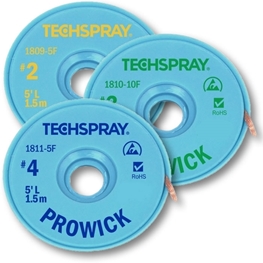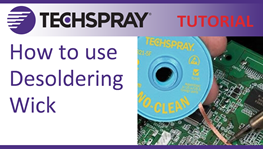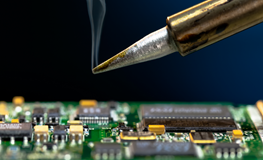Fast & Easy PCB Repair & Rework with Desoldering Wick
Techspray wick has been a mainstay at PCB rework, repair and prototyping stations for over 30 years. Available in 6 different widths, pretreated with rosin flux, no-clean flux, or unfluxed.
It is available in static dissipative bobbins for static sensitive environments, and in two different flux types as well as unfluxed:
- No-Clean desoldering braid - coated with proprietary flux that only leaves a slight clear residue, which does not cause dendritic growth, corrosion, or other service issues. Cleaning after using Techspray No-Clean wick is optional.
- Pro-Wick desoldering wick - coated with a fast-activating rosin flux for lightning-fast solder removal.
- Unfluxed desoldering braid - ideal for customers that use an aqueous flux or who are required to maintain the same flux throughout board assembly and rework.
All Techspray desoldering braids are effective solder removers, are effective on lead and lead-free solders, are compliant with RoHS, and do not contain SVHC as defined by REACH.
For more information, check out our Ultimate Guide to Electronic Soldering.
Specifications: Meets or Exceeds MIL-F-14256; NASA NHB 5300, 4 (34-1); NASA NPC 200-4; NASA SP5002; 1821:HP 8690-0588; 1823: HP 8690-0577; IPC Standard-J-STD-004
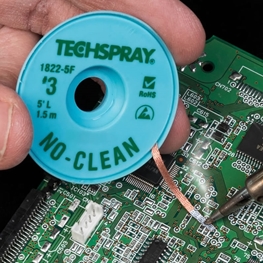 No-Clean Desoldering Braid
No-Clean Desoldering Braid
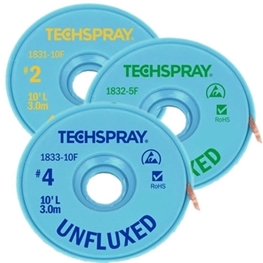 Unfluxed Desoldering Braid
Unfluxed Desoldering Braid
FAQ's
Step 2: Place the tip at an angle that maximizes heat transfer through the braid to the solder. Use a clean tip that you have just tinned with fresh solder to maximize heat transfer. Heat will be moving up the copper, so be careful not to burn yourself.
Step 3: Apply slight pressure and wait for the solder to melt. Don’t get in too big of a hurry at this point. Allow the tip to dwell long enough on the wick to heat the wick and then the solder on the other side. You will see the wick begin to absorb the solder. Hold the tip and wick in place until the wicking action has stopped.
Step 4: Remove the wick and braid at the same time. Removing the iron before removing the wick can cause the wick to become soldered to the board. If that does happen, reheat the braid so that you can remove it.
Check out our video how on how to use desoldering wick.
Out-of-date solder wick can create a performance issue. As more oxidation builds on the copper braid, it will take longer to activate and draw up solder. It will slow down a little month-to-month until eventually the performance will be unacceptable. We estimate this to be 2-years based on average storage conditions. Wick in storage wrapped up tight can last longer, while a loose bobbin sitting on a benchtop will probably go bad sooner.
An operator will generally have a feel for how wick performs and will have an opinion on when performance is unacceptable. The main risk of using out-of-date wick is thermally stressing the working area, adjacent components, etc. When an operator tries to make due with old wick that is underperforming, they tend to turn up the heat on their iron, or keep the tip in contact with the wick and work for a longer period of time.
So whether or not out-of-date wick is considered good depends on the criticality and conservativeness of your process. An average shop would keep using it until it stops working well. A very conservative process (e.g. for class 3 electronics) could require wick in stock to be discarded at the expiration date, and loose bobbins at workstations replaced periodically (i.e. weekly or monthly).
Techspray uses 2 types of flux: Prowick line is a natural gum rosin. Per J-STD-004 Section 3.2, the Prowick is classified as ROL0. Per British Std. EN 29454-1:1993 and ISO9454-1:1990, Prowick has a classification of 1.1.1.B. No-Clean flux is a synthetic (non-colophony)flux. Per J-STD-004 Section 3.2, it is classified as REL0. Per British Std. EN 29454-1:1993 and ISO9454-1:1990, the No-Clean flux has a classification of 1.2.3.B.


